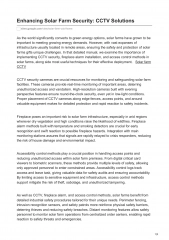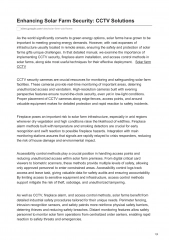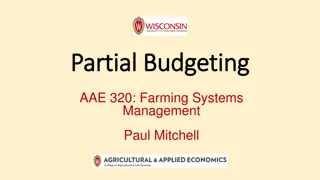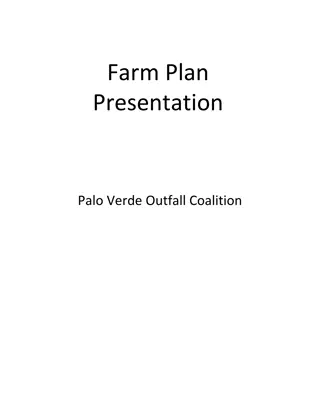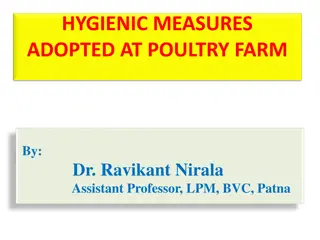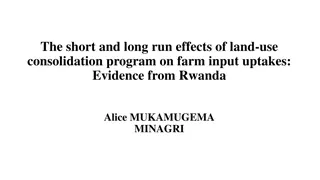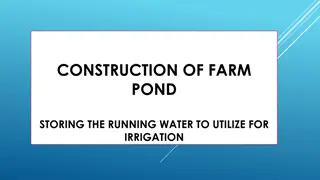Farm Financial Health Insights
Dr. Alex Doc White from VT Dairy Science offers valuable guidance on assessing your farm's financial health through production measures, financial analysis, liquidity, solvency, profitability, financial efficiency, and financial ratios. Discover the key areas to focus on and learn how to interpret important financial benchmarks to make informed decisions for your farm's prosperity.
Download Presentation

Please find below an Image/Link to download the presentation.
The content on the website is provided AS IS for your information and personal use only. It may not be sold, licensed, or shared on other websites without obtaining consent from the author.If you encounter any issues during the download, it is possible that the publisher has removed the file from their server.
You are allowed to download the files provided on this website for personal or commercial use, subject to the condition that they are used lawfully. All files are the property of their respective owners.
The content on the website is provided AS IS for your information and personal use only. It may not be sold, licensed, or shared on other websites without obtaining consent from the author.
E N D
Presentation Transcript
Understanding Your Farms Financial Health Dr. Alex Doc White VT Dairy Science DocWhite@vt.edu
Production Measures Conception %, Heat Detection Rate Lbs milk/cow Tons/acre, bu/acre, etc. Compare to averages & look for trends Identifies production issues (good & bad) Same goes for financial ratios
Financial Analysis What you need: Income Statement Ideally 3-5 years of these statements Aka Schedule F or P&L Balance Sheets List of Financial Benchmarks Calculator or spreadsheet Common Sense
Areas of Importance Liquidity How quickly can you put your hands on cash? Solvency How much of your farm do you own vs your creditors? Repayment Ability ( capacity ) How able are you to make your loan payments?
Areas of Importance Profitability How much is your firm earning, after all expenses? The bottom line (before taxes) Financial Efficiency How well are you controlling your costs? How well are you using your assets?
Financial Ratios Compare a ratio to its industry benchmark Look for trends over time Identify ongoing problems Look for ways to improve a bad ratio Identify the problem and possible corrective actions
Liquidity Current Ratio = Current Assets / Current Liabilities These come from your balance sheet Benchmark: (Green > 1.5 Red < 0.8) Higher is better, to a point You have $1.50 in current assets for every $1.00 of current liabilities How liquid are your current assets? Cash, savings, feed inventories, prepaid expenses, etc.
Liquidity Working Capital / Expenses = (CA CL) / Total Expenses Total Expenses comes from your Income Statement (Schedule F) Benchmark: Green > 25% Red < 15% Higher is better, safer You have enough liquidity to cover (3 months) of your annual expenses More lenders are looking at this ratio today It relates your liquidity to the size of your operation
Liquidity What if it s low? Potential cash flow problems More susceptible to financial potholes You have less management flexibility No cash to take advantage of opportunities Need strong cash flow & profitability
Liquidity How to improve: Build up your savings account Build feed or supplies reserves as appropriate Sell unneeded assets & pay down debts (Bird Poop Principle) Start by paying down your operating loans Improve the efficiency of your operation
Liquidity How to improve (continued)? No new borrowing Stretch your loans over a longer term to lower your payments
Solvency Equity / Asset Ratio = Net Worth / Total Assets These come from your balance sheet (Green > 70% Red < 30%) Benchmark: Higher is safer You have paid outright for 70% of your assets For Young/Beginning Farmers -- > 30% During/After Transition involving new debt -- > 30%
Solvency What if your solvency is low? More of your cash flow is earmarked for debt payments Less management flexibility How to improve: Sell unneeded/under-used assets & pay down debt Lease vs own; borrow; co-own; go without Improve profitability & pay down debt, add to savings
Repayment Capacity Debt Coverage Ratio Debt Repayment Capacity / Total P&I Payments Net Farm Income, Depreciation, & Interest Expense come from your Income Statement Net Farm Income + Depreciation & Interest Expense + Non-farm Income - Family Living & Income Taxes (or Owner Withdrawal*) = Debt Repayment Capacity
Repayment Capacity Benchmark: Higher is better (Green > 150% Red < 110%) Tells you how much cash you have available to make your P&I payments $1.50 of cash for every $1 of loan payments due this year
Repayment Capacity How to improve: Increase revenues Quantity sold, selling prices, improved quality or consistency, new products Decrease expenses (top 5) Feed/feeding system, vet, labor, interest, etc. Refinance your debts Lower APR, longer repayment terms Reduce family living expenses, increase non-farm income
Profitability ROA: Rate of Return on Assets (Net Farm Income + Interest Mgt Fee) Total Farm Assets Mgt Fee = Owner Withdrawal or Family Living Expense (Green > 8% Red < 3%) Benchmark: Greater than your cost of money (APR) Greater than the rate of inflation (3%) Higher is better, to a point
Profitability If it s too low: Living off depreciation or paper gains Will have trouble replacing assets when they wear out . Must make profits to stay in business long term will the transition help? To improve: Increase revenues Decrease top 5 expenses Get rid of unneeded or under-used assets
Financial Efficiency Operating Expense/Receipt Ratio (Total Expenses Depreciation Interest) / Gross Revenues These come from your income statement. Benchmark: (Green < 70% Red > 85%) Lower is better, to a point Measure of cost control It costs $0.75 in operating costs to generate $1 of sales. Leaves $0.25 for taxes, family living, interest, depreciation, etc.
Financial Efficiency What if your Op Exp/Rec ratio is too high? Lower profitability; cash flow problems Higher operating needs; loan repayment problems How to improve: Decrease top 5 expenses without hurting production Increase revenues (pricing, quantity sold, etc.)
Financial Efficiency Capital Turnover Ratio = Gross Sales / Total Assets Gross Sales comes from the Income Statement Total Assets comes from the Balance Sheet (Green > 40% Red < 15%) Benchmark: Higher is better Measure of how much revenue you are generating from your assets Idle assets are killers!
Financial Efficiency If it s too low Too many idle or unproductive assets Lower for land-intensive enterprises How to improve: Get rid of unneeded or under-used assets Generate more sales with existing assets Find new uses for your assets - Custom work?
Use The Ratios to Improve Powerful information You already have the info use it Compare to benchmark, look for trends Capitalize on your strengths Identify potential problems BEFORE the transition Improve your relationship with your lender!




